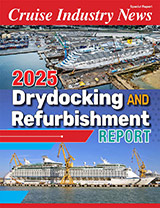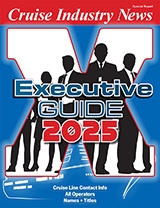The Star Cruises Group has reported a net loss of $101.4 million for 2003, compared to net income of $1.2 billion for Carnival Corporation (CC) and $280.7 million for Royal Caribbean International (RCC).
Star operated 18 ships with 23,000 berths in 2003, compared to 71 ships and 113,000 berths for CC and 27 ships and 57,540 berths for RCC.
2003
Star reported a net loss of $101.4 million, or $2.04 per share, on revenues of $1.6 billion for the year ended Dec. 31, 2003, compared to net income of $73 million, or $1.64 per share, on revenues of $1.5 billion for 2002.
According to Star, revenues for 2003 were driven by increased capacity, offset by lower cruise ticket prices and shipboard revenues as well as lower occupancy.
Star attributed lower yield and occupancy to the effect of SARS in the Asia Pacific region in 2003.Operating expenses increased mainly due to higher fuel costs; costs incurred in response to the SARS outbreak; and expenses related to the start-up of its new Hawaii operations and relating to the Norway which bas been laid up since May 2003.
One-Time Costs
Star said that it recorded net income of $7.3 million before impairment losses and non-recurring expenses for 2003, compared to net income of $82.6 million before non-recurring expenses in 2002.
Star attributed $95.5 million of impairment losses in 2003 to its policy of disposing of older ships and the trade names and trade marks.
The recent sales of the Superstar Capricorn and the Superstar Aries were part of what Star calls its fleet rejuvenation plan.
Star plans to modernize its Asian fleet by progressively replacing older tonnage in the Star Cruises fleet with mid-sized ships from Norwegian Cruise Line (NCL) as new ships are added to that brand.
As part of that strategy, Star said it is “on the look-out for opportunities to dispose of other older Star Cruises ships.”
In 2003, Star also made prov1S1ons for legal settlements and related costs in the amount of $18.5 million.
Partially offsetting these costs were $5 .3 million in proceeds from the loss-of-hire coverage resulting from the Norway’s boiler accident.
Pride of America
The Pride of America is now being inspected in drydock to detennine the extent of the damage and what is likely to be a substantial delay in the delivery, while the repair and replacement parts are being prepared, according to Star.
Meanwhile, certain clauses in the loan agreement to partially finance the newbuilding entitle the lenders to accelerate the loan which could become immediately repayable, Star said in a prepared statement.
Also, due to the possibility of a default under this loan, other loan facilities could also be deemed in default due to cross default clauses and others could be deemed in default in the event that lenders accelerate loan repayments, according to Star, which said it was confident that the potential defaults will be remedied by obtaining waivers from the lenders or by taking other measures necessary to address the issue satisfactorily.
Q4
Star reported a net loss of $128.9 million, or $2.56 per share, on revenues of $400 million for the fourth quarter ended Dec. 31, 2003, compared to a loss of $19 million, or $0.40 per share, on revenues of $368.4 million for the same quarter in 2002.
According to Star, the net loss would have been $14.8 million for Q4 last year, without the impairment loss and non-recurring expenses, compared to $19 million in 2002.
Star Cruises
Star Cruises operated with 7. 7 percent lower capacity days in Q4 2003, compared to Q4 2002. Occupancy and net yield were both down compared to 2002, according to Star.
For the year 2003, Star Cruises operated with 2.8 percent lower capacity days compared to 2002. Occupancy and net yield were down nine percent and 12 percent respectively, according to Star, which attributed the decline to weaker demand following the outbreak of SARS in Q2 2003.
Fuel costs were also up and the company incurred $5.3 million in extra costs in response to the SARS outbreak. Excluding fuel costs and SARS expenses, Star said total operating and SG&A expenses per capacity day were 1.9 percent lower in 2003 over 2002.
The Avian-flu outbreak in the region has not affected bookings thus far. Barring any further deterioration of the outbreak, Star said it expects Q1 04 in Asia to recover the level achieved in Q1 03.
Fleet Shuffles
The company’s focus now is to modify the profile of its Asian fleet to one with a larger number of relatively modern ships of medium capacity. These medium-capacity ships will be more cost effective in developing new markets, Star said. Three or four medium-capacity ships will also provide greater flexibility compared to one or two mega-ships, offering more itinerary options and seasonal deployments, according to Star.
As NCL’s newbuilds of 2,000-plus lower berth capacity are delivered, Star said it plans to move NCL’s modern mid-sized ships of 1,200 to 1,500 lower berth capacity (read: Norwegian Crown, Norwegian Sea and Norwegian Majesty) to Asia.
Star described the Superstar Capricorn and Superstar Aries, which were recently sold for undisclosed amounts, as “less cost effective in Asian operations” and said that “these disposals will immediately eliminate the impact of the generally loss making old tonnage.”
As the NCL ships are introduced in Asia over what Star called the “medium term,” it said it will have a fleet of increasingly more modern and cost effective capacity.
NCL
NCL operated with 0.8 percent fewer capacity days in Q4 03 compared to the same quarter in 02. Occupancy and net yield were up 1.9 percent and 2.6 percent over the previous quarter, while ship operating costs did not change and SG&A expenses were down three percent.
Q4 ended well for NCL, with bookings coming on stronger than originally forecast both in price and volume, Star said. The cost build-up in advance of the U.S. flag operations were offset by cost savings in the brand’s main business.
For the full year of 2003, NCL operated with 5.5 percent more capacity days year-over-year. Occupancy and net yield were 0.3 percent and 0.7 percent higher, respectively.
Operating costs were up, impacted by higher fuel costs and maintenance of the Norway in lay-up.
The weakness in the first half of the year, was largely, though not fully, reversed in the second half as NCL experienced a good Q3 and a strong Q4.



